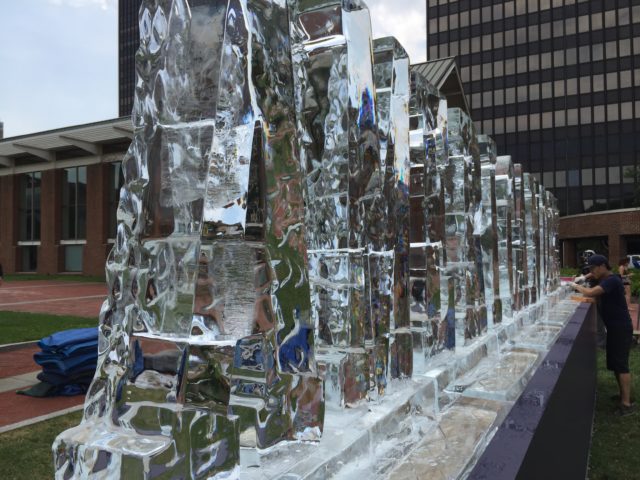Anna Maria Hong, Philadelphia

It is in the nature of ice to expand, unlike other substances that shrink when transforming from liquid to solid. Ice will shatter a glass container, make metal bulge and pop, if you don’t keep its physical properties in mind when handling it or placing it in a vessel, where it will be shaped and temporarily constrained before reverting back to water, back to vapor. Water wants to travel. Ice wants to grow.
Water, the element of emotion and life itself, is not like the other players. Because of its strange characteristics, ice is a specialized subject of inquiry: some physicists devote their careers to studying just ice. Ice is unique, a substance unto itself.
The ice sculpture embodying the words “The American Dream” is being installed on Independence Mall, melting as it’s being erected, letter by letter, even though each letter rests on its own pedestal of dry ice. The weather app says it’s 97 degrees, and it feels like 99% humidity.
When I first heard of this installation, I thought about how much I like ice, how beautiful it is, how consoling and delightful on a blazing summer day like today or as snow in a winter blizzard. I also first thought that the metaphor was a bit on point.
The American Dream melting before our eyes: we know this, we’ve known it for a long, long time. Journalists, climate scientists, economists, and many other writers and scholars have documented the numerous ways in which the idea of equal opportunity has been liquefied in recent times. For some of us, our entire lives have been and will be saturated with a hobbled, holey, insulting, or irrelevant version of the notion that is the dream.
But then, melting and evaporation don’t equal disappearance. The solid subject de-materializes in only one dimension and mostly in just one physical sense—vision, our most overrated and exhausted path of perception—as what was once seemingly solid before our eyes transforms into something else—water then vapor.
As water, the subject will travel downward through wood, grass, dirt, bones, colonies, roots, and worms, feeding flora and fauna along the way. As vapor, the subject will travel upward through the atmosphere, the sky, forming fog and clouds, the most democratic of nature’s spectacular displays, as virtually anyone can see clouds at any time in any place—on land or at sea, in the bowl of a canyon, at ground level or elevation.
It takes hundreds of billions of tiny droplets to make one cloud, which appears corporeal but embodies ephemerality, movement, change.
Some of the molecules will make their way back to being ice, presumably not formed into words or slogans again, but you never know.